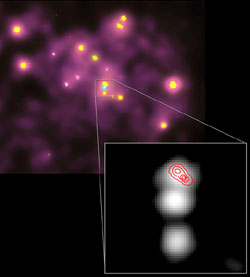Closer Look Reveals Andromeda's Black Hole Not As "Cool" As Believed
October 12, 2001
On January 14, 2000, a team of astronomers using NASA's Chandra X-ray Observatory announced the discovery of an unusual source very near the nucleus of the Andromeda Galaxy, also known as M31. The proximity of this source to the nucleus, and its extraordinarily low temperature relative to other X-ray sources in M31, led the astronomers to associate it with the supermassive black hole located at the center of M31. These results were extraordinary because they could not be explained by the standard models developed for supermassive black holes in galaxies like the Milky Way and Andromeda. However, recent observations with NASA's Hubble Space Telescope and analysis of additional Chandra observations of M31 by the same team have shown that this association was in error.
The team, led by Michael Garcia of the Harvard-Smithsonian Center for Astrophysics, Cambridge, Mass., has recently detected two X-ray emitting globular star clusters - so called because of their spherical shape - in the vicinity of the M31 supermassive black hole. The globular clusters, which are visible on both Hubble and Chandra images, can be used as a cross-check to determine the position of all of the X-ray sources near the supermassive black hole to an accuracy ten times greater than before.
These new and slightly revised positions show that the very cool X-ray source is actually located approximately 1 arcsecond south of the supermassive black hole. A second, hotter X-ray source, is found to have a location that is consistent with the position of the super-massive black hole, but the astronomers caution that, due to the complex nature of the region, it is not possible at this time to say with certainty that this source is due to the supermassive black hole.
Images associated with this release are available on the World Wide Web at:
MEDIA CONTACTS
Steve Roy
Marshall Space Flight Center, Huntsville, AL
Phone: 256-544-6535
Megan Watzke
Chandra X-ray Observatory Center, CfA, Cambridge, MA
Phone: 617-496-7998



